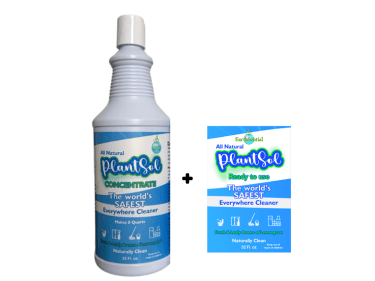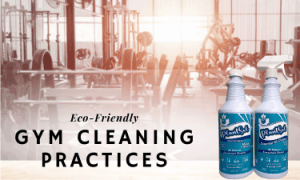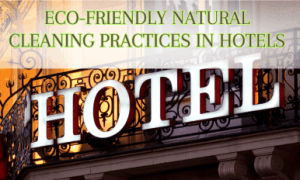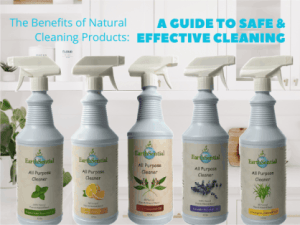For years, the practice of using a bleach and water mixture to clean school desks has been a standard procedure, seemingly harmless in its intention to keep classrooms free of germs.
However, beneath this seemingly innocuous solution lies a hidden danger, especially for the very individuals it aims to protect: our children.
The side effects caused by bleach exposure are far-reaching, from irritating the eyes and skin to triggering respiratory problems.
In this changing landscape of awareness about environmental health, it’s imperative to scrutinize our cleaning methods closely.
Rethinking School Cleaning for a Safer Tomorrow
Transforming schools with green cleaners is a vital step toward creating healthier learning environments for students and staff, replacing traditional methods with eco-friendly alternatives.
Let’s explore these safer, more sustainable options that are ushering in a new era of school cleaning—one that prioritizes the well-being of our students and educators alike.
Table of Contents
Rethinking School Cleaning for a Safer Tomorrow
The Shift in Perspective: Recognizing the Need for Change
Vermont Leads the Way: Enforcing Green Cleaning in School
The Benefits of Green Cleaning: Creating Healthy Learning Environments
The Future of School Cleaning: A Nationwide Shift Towards Sustainability
Building a Healthier Educational Environment for All

The Shift in Perspective: Recognizing the Need for Change
In recent years, there has been a significant shift in perspective within states and educational institutions, as they increasingly recognize the inherent dangers posed by chemical cleaning solutions, particularly in educational settings.
The once overlooked hazards of these cleaning agents, especially in the context of schools, have sparked a wave of awareness that is rippling across the nation.
This growing understanding revolves not only around the immediate health risks faced by students, teachers, and staff due to exposure to harsh chemicals but also the long-term environmental impact.
As the world steers toward a more sustainable future, there’s a pressing need for a safer, eco-friendly alternative to traditional cleaning methods.
This awareness resonates at the highest levels of governance; initiatives like President Joe Biden’s 2030 Greenhouse Gas Pollution Reduction underline the urgent call for clean air and water, emphasizing the crucial role of eco-conscious practices in safeguarding our communities.
The time for change is now, and the momentum is building towards adopting cleaning solutions that not only disinfect but also nurture a healthier, greener tomorrow for our educational spaces.

Vermont Leads the Way: Enforcing Green Cleaning in Schools
In the realm of progressive education and environmental consciousness, Vermont stands tall as the pioneer state in enforcing green cleaning practices within its school system.
With a visionary approach toward fostering healthier learning environments, Vermont’s Department of Education has taken bold and proactive initiatives to implement and regulate green cleaning practices in schools.
These efforts signify a monumental shift, emphasizing the state’s commitment to not only academic excellence but also the overall well-being of its students, teachers, and staff.
Vermont’s journey into the realm of green cleaning serves as a beacon, illuminating the path for other states and educational institutions to follow, as they too venture into the realms of eco-friendly, sustainable, and health-conscious school environments.

The Benefits of Green Cleaning: Creating Healthy Learning Environments
Embracing green cleaning practices in schools not only signifies a commitment to environmental sustainability but also nurtures healthy learning environments with a multitude of advantages.
- One of the primary benefits lies in the significant improvement of indoor air quality. Traditional cleaning products often release harmful chemicals into the air, contributing to respiratory issues and allergies among students and staff. Green cleaning, on the other hand, utilizes natural ingredients, reducing the risk of harmful emissions and creating a fresher atmosphere conducive to learning.
Green cleaning minimizes exposure to hazardous chemicals. Students, especially young children, are more susceptible to the adverse effects of chemical exposure. By opting for eco-friendly cleaning solutions, schools can eliminate the risks associated with traditional cleaners, ensuring a safer environment for everyone within the premises.
- The enhanced overall health of students and staff is another compelling advantage of green cleaning. By reducing exposure to toxins and irritants, schools promote the well-being of their community. Fewer allergies, respiratory issues, and skin irritations mean students can focus better on their studies, and teachers can perform their duties without the hindrance of health-related concerns.
In the pursuit of green cleaning, schools can turn to a variety of eco-friendly cleaning products. These include natural disinfectants made from essential oils like tea tree or eucalyptus, vinegar-based solutions for surface cleaning, and plant-based detergents for maintaining hygiene.
These products not only match the effectiveness of their chemical counterparts but also contribute to the overall sustainability of the school environment.
- By embracing green cleaning, schools not only invest in the health and well-being of their occupants but also set a valuable example for the community. As students thrive in clean, healthy environments, they learn the importance of sustainability, fostering a sense of responsibility for the environment and the future.
- Ultimately, the benefits of green cleaning extend far beyond the classroom, shaping conscientious individuals and nurturing a greener, healthier planet.
The Future of School Cleaning: A Nationwide Shift Towards Sustainability
Vermont’s pioneering steps in enforcing green cleaning practices within its school system serve as a beacon of inspiration for states and school districts across the nation.
The success of Vermont’s initiative not only underscores the feasibility of eco-friendly cleaning practices but also highlights the urgent need for a nationwide shift towards sustainability in educational institutions.
One of the key drivers for this shift lies in awareness campaigns and education. By raising awareness about the harmful effects of traditional cleaning chemicals and promoting the benefits of green cleaning, communities can advocate for change.
Schools can play a pivotal role in educating students, parents, and staff about the importance of eco-friendly cleaning practices. Integrating such knowledge into the curriculum instills a sense of responsibility towards the environment from an early age.
Community involvement is equally essential. Local communities, including parents, teachers, and school board members, can actively participate in shaping school policies that prioritize the health and well-being of students and staff.
Engaging in dialogues, attending town hall meetings, and supporting initiatives that promote sustainable practices can significantly influence the decisions made by school districts.
Additionally, collaboration between educational institutions, local governments, and eco-friendly cleaning product manufacturers is crucial.

Schools can partner with green cleaning product suppliers to procure affordable, effective, and environmentally friendly cleaning solutions. This collaboration not only supports local businesses but also ensures a consistent supply of eco-friendly products for schools, making the transition to green cleaning more seamless.
Furthermore, financial incentives and support from government agencies can encourage schools to adopt green cleaning practices. Subsidies, grants, or tax benefits for purchasing eco-friendly cleaning supplies can alleviate the initial costs, making it more economically viable for schools to make the switch.
As more states and school districts recognize the social, environmental, and economic benefits of green cleaning, a nationwide movement towards sustainability in school cleaning practices becomes not just desirable but imperative. By fostering a collective commitment to eco-friendly initiatives, communities can pave the way for a cleaner, healthier future, one school at a time.

Building a Healthier Educational Environment for All
In embracing the green cleaning revolution, schools not only safeguard the health and well-being of their students and staff but also set a transformative precedent for the future of education.
The journey toward eco-friendly cleaning practices isn’t just a choice; it’s a responsibility we owe to the current and upcoming generations.
By prioritizing green cleaning, schools create more than just clean classrooms; they foster environments where students can thrive, learn, and grow without the threat of harmful chemicals.
Cleaner air, reduced exposure to toxins, and improved overall health become integral parts of the educational experience, shaping not just academic success but also life-long well-being.
As we conclude, the call to action echoes loud and clear: let’s stand together as advocates for green cleaning practices. Schools, communities, and policymakers must join forces to prioritize the health of our educational spaces.
By supporting initiatives, raising awareness, and demanding change, we can ensure a safer and healthier learning environment for all, leaving a legacy of well-being and sustainability for generations to come.
Together, let’s commit to building a future where every school is a haven of health, where every child can learn and thrive in an environment that nurtures their potential and protects their health.
The journey begins now, and it begins with us. Let’s make every school a sanctuary of learning, where green cleaning isn’t just a choice but a fundamental right for every student and educator.


Plantsol Super Concentrate w/spray bottle
$27.99
100% natural with family safe ingredients. Amazing for the kitchen, bathroom, countertops, floors and pet items.
All Natural & Plant-based Ingredients
Cleans, degreases, deodorizes, removes stains & aromatherapy benefits
Makes 8 Quarts = Less than $3.49 each quart
Size: 32oz Scent: Mixed Essential Oil
About the Author

Bonnie Pellerin
Microbiologist
Bonnie Pellerin, a Biotechnology graduate and seasoned microbiologist, specializes in identifying bacteria and mold. Alongside her formulating chemist husband, she co-founded EarthSential, driven by their shared mission to create a safe haven free from harsh chemicals for their children and others. Bonnie’s expertise and dedication continue to shape the field of biotechnology and environmental safety.
Eco-friendly Gym

Cleaning practices wanted now
by Bonnie Pellerin Ι Oct 12, 2023 Ι 5 Min Read
Natural Cleaners

in nursing homes isn’t a preference
by Bonnie Pellerin Ι Oct 12, 2023 Ι 5 Min Read
Eco-friendly

natural cleaning practices in hotels
by Bonnie Pellerin Ι Oct 12, 2023 Ι 5 Min Read
Boosting

Productivity with clean workspaces
by Bonnie Pellerin Ι Oct 10, 2023 Ι 5 Min Read
Toxic Cleaners Exposed

Make the Switch Today
by Bonnie Pellerin Ι June 29, 2023 Ι 5 Min Read
The Dangers of Chemical Cleaners

Exploring the Dangers
by Bonnie Pellerin Ι July 11, 2023 Ι 5 Min Read
A guide to safe

and effective cleaning
by Bonnie Pellerin Ι June 7, 2023 Ι 5 Min Read
How Going Green

Benefits the Environment
by Bonnie Pellerin Ι July 11, 2023 Ι 5 Min Read
Impact of cleaning

chemicals on cellular health
by Bonnie Pellerin Ι Jun 29, 2023 Ι 5 Min Read
Cleaners and the

Hormone Disruption Crisis
by Bonnie Pellerin Ι June 8, 2023 Ι 5 Min Read
The Power of Nature

How Peppermint, Clove and Thyme Work Together to Repel Rodents
by Minus Bite Ι May 3, 2023
Get the EarthSential Newsletter
Good deals, great advice & essentially necessary.


